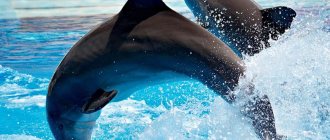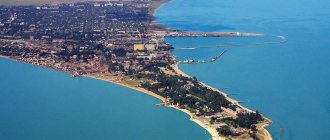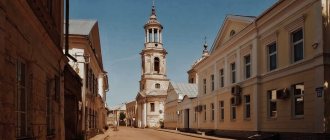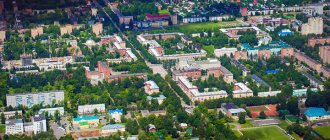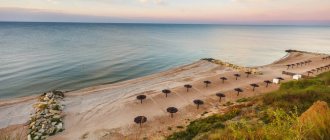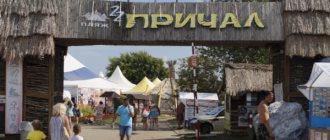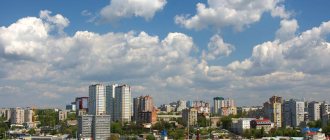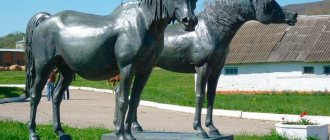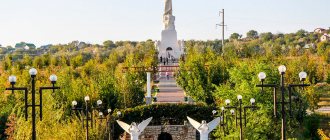Amazingly beautiful places, clean sea air, silky beaches and a lot of diverse attractions - this is only a small part of what Yeysk can offer tourists.
The cultural, historical, entertainment, ethnographic and educational sites of both resorts “stretch out in a row” along the Azov coast and therefore they can be viewed one after another without building complex routes.
We talk about what to see in Yeysk, what excursions to go on, and where the most outlandish corners of this fertile land are hidden, in our material.
Fountain in the Ataman ethno-complex. Photo: taman.club
The attractions of Yeysk are not so few for a small town, which over the 170 years of its existence has managed to turn into a major port and a popular resort.
About the history of the city of Yeysk
The port city of Yeisk was founded in 1848 with a specific purpose: as a base for the sale of grain and other agricultural products of the Kuban, Don, and Stavropol regions abroad. The new port was built at the base of the Yeisk Spit - a narrow sandy peninsula washed by the waters of the Taganrog Bay and the Yeisk Estuary of the Azov Sea. The name comes from the Eya River, the mouth of which is located next door.
Just seven years after its founding, the city was severely destroyed by attacks by an English squadron during the Crimean War of 1853-1856. However, it was restored and by the beginning of the twentieth century it became one of the largest economic and cultural centers in the region. The port was reconstructed; the city is connected to the railway. Its history as a resort began in 1912: a balneological health resort was opened in Yeisk, with treatment with mud and hydrogen sulfide waters.
The Civil War and the Great Patriotic War became serious shocks for the city. During the civil period, Yeisk became the scene of bloody battles between the Reds and Whites, and changed hands many times. During the Great Patriotic War, he was subjected to heavy bombing by German aircraft and was under fascist occupation for six months.
Badges with the coat of arms of the city of Yeysk.
During Soviet times, the city grew several times: active housing construction began here. In addition to the seaport, a higher military aviation (originally naval aviation) school was located here. It was disbanded in 2011.
A distinctive feature of the old city is strictly perpendicular and parallel streets, squares of the correct shape - initially Yeysk was built up in strict accordance with the general plan, and not spontaneously. Modern Yeysk is a colorful collection of architecture from three eras: tsarist times, Soviet and architecture of the late 90s / early 2000s.
On the coat of arms of the city of Yeysk there is a diagonal wavy azure band, on which is applied a golden sterlet with red fins. This version of the coat of arms was given to the city in 1875 and restored in 1992. In Soviet times, the coat of arms of Yeysk depicted the sun rising from the waves and a soaring seagull, with an ear of corn and a gear obligatory for Soviet heraldry at the bottom of the coat of arms.
Climate and ecology of Yeysk. Alarm bells
The climate of Yeisk is the same as throughout the coastal territory of the Krasnodar Territory: hot summers, warm seas, short, almost snowless winters without much frost. In mid-April, spring is already in full bloom in the city, and cold, rainy autumn comes only in October, after the sunny “Indian summer”. Rain in the warm season is rare, mainly in the form of short showers. Strong winds cause some inconvenience, but you quickly get used to them.
The local climate has a very beneficial effect on people suffering from cardiovascular, bronchopulmonary, skin diseases and various allergies. It’s not for nothing that Yeisk is called a climatic resort. At the beginning of the 20th century, springs of mineral waters and deposits of medicinal silt mud were found here, which was the reason for the increase in the flow of vacationers and migrants.
As in all actively developing port cities, in Yeisk there are problems associated with environmental pollution by port-based industrial enterprises and frequent accidents on ships transporting oil and other products that are dangerous from the point of view of environmentalists. The opening of an oil terminal in the city caused a lot of protest among local residents. In November 2011 In Yeisk, there was a leak of fuel oil from a tanker that had not been cleared of the remnants of previously transported liquefied gas, and at the time of refueling, these remnants were vented into the atmosphere. Such an incident, unfortunately, is not isolated.
Island of the Seven Winds
Previously, this island, located three kilometers from the end of the Yeisk Spit, was a single whole with it. But in 1914 the spit was washed away by a strong storm. The uninhabited Island of the Seven Winds has a bizarre shape and is home to a variety of seabirds. The island can be reached by boat, or along with an excursion.
Excursion booking address: st. Beach, 1.
"Azov City"
Where to go in Yeisk in the evening? 50 kilometers from the city, on the border of the Krasnodar Territory and the Rostov Region, there is a federal gambling zone. Today there are three casinos here:
- "Oracle";
- "Fenugreek";
- "Nirvana".
There is also a hotel complex in the zone. In the first quarter of last year alone, 112 thousand people visited Azov City. However, back in 2015, the government decided to close the gambling zone, which should finally happen on January 1 next year. Naturally, entrepreneurs who have invested millions in this matter are very indignant and are collecting signatures against the liquidation of the zone, but so far the decision has not been changed.
Long braid
The Dolgaya Spit is a natural border between the Taganrog Bay and the main part of the Azov Sea. Its length is approximately 8-10 kilometers, and all of these are beautiful sandy and shell beaches. This nature reserve is also interesting because there are excellent conditions for surfing, and surfers from all over Russia come here every year to ride the sea waves.
On the Long Spit.
Khanskoye (Tatar) Lake
A closed steppe reservoir sixty kilometers from Yeisk, in the southern part of the Yeisk Peninsula. The length of the lake is about 16 km, width - from 6 to 7 km, maximum depth (in spring) - up to two meters, in summer - only 5-10 cm. The magnesium-sodium and sulfate-chloride water of Lake Khan is saturated with minerals and salt. In ancient times, in the summer, during drying out, table salt was mined from the bottom of the lake, and the income from this fishing went to the treasury of the Crimean Khan, who, after the annexation of Crimea, could no longer live, as before, by predatory raids on Russian lands and became a vassal of Russia.
Summer on Khanskoye Lake.
Nowadays table salt is not mined here. But medicinal mud and brine - yes. The composition is similar to the mud of Lake Saki, Odessa Estuary, and Tambukan Lake in Pyatigorsk. It helps to cope with diseases of the nervous and cardiovascular systems, digestive organs, joints, and maintain the freshness and beauty of the skin. The flora and fauna around the reservoir is also rich. Especially ornithological - cormorants, pelicans, flamingos, and laughing gulls live in its vicinity.
Ethnographic Museum "Kuban Farm"
An elegant and colorful ethno-village is located a 15-minute drive from Yeysk, in the picturesque village of Morskoy. The stylized Kuban village is imbued with the customs, traditions, and life of the Cossacks, and looks natural and extraordinary.
All the things in the museum are original: lace, clothes, household items, dishes, carpets and even icons were brought here by the creators of the museum from the villages and cities of the Krasnodar Territory. Each exhibit has its own interesting story, which the Cossack guide will tell you about.
After viewing the exhibition, guests are invited to the table to taste borscht, lard with homemade bread, vodka, uzvar and honey from the local apiary. There are other facilities on the territory of the farm: a stable with thoroughbred stallions, a mini-farm, a children's playground, a swimming pool, a watchtower and a souvenir shop.
"Kubansky farm". Photo: tourister.ru
What is so beautiful about the south of Russia is that even the smallest corner is rich in beautiful places and entertainment.
What about the sea? Here you can choose the most suitable beach in Yeysk.
Park and Museum named after Ivan Poddubny. Other city parks
In Yeisk, they do not forget that the famous wrestler and athlete Ivan Poddubny (1871-1949) settled here after completing his sports and circus career. His grave, with the inscription “Here lies the Russian hero,” is located in the largest local park, which is now named after the great athlete. The Poddubny Memorial Museum is also located here. Monuments to the fighter stand both near the museum and at the main entrance to the park (from Pervomaiskaya Street).
The park has existed since 1898: it was then that a green zone was created on this site for cultural recreation of citizens and guests of the city. Nowadays, it pleases with its picturesque and well-groomed appearance: magnificent fountains, flower beds, lawns, forged fences and art objects, paving slabs and small architectural forms. There is plenty of space for kids to roam: playgrounds, more than thirty attractions, a mini-zoo, and annual circus tours. There are shooting galleries and billiard rooms for adults. There are cafes. The park contains one of the richest collections of attractions in Russia. This is not an accident: in Soviet times, it was in Yeisk that the company producing this specific product worked.
Poddubny Museum and a monument to the fighter near it.
In the hall of the one-of-a-kind museum of Ivan Poddubny, everything is decorated like the arena of an ancient circus tent. The exhibition includes more than two thousand different exhibits, clearly telling about the life of the great athlete and the history of classical wrestling. There are also Poddubny’s personal belongings. Among them is an embroidered oriental robe, in which he entered the arena; a souvenir bill that the wrestler gave to the daredevil who could survive one minute in a fight with him without falling; a cast iron cane with which a wrestler walked.
Not far from Poddubny Park, on Karl Marx Street, there is the second largest green area of Yeysk - the city park named after Gorky. It is notable for its monuments and sculptures. There are also playgrounds and cafes here.
Next to the city Palace of Culture is Nikolsky Park (formerly Kalinin Park). It has a round shape. Next to the Taganrog embankment there is a well-maintained Primorsky Park. Its most picturesque part is located next to the Cossack Kuren, at one of the descents to the sea.
Address: st. Pervomaiskaya, 189/1
The best beaches of Yeysk
Central Beach
Central Beach
The central beach of Yeisk is located in the northern part of the city, on the shore of Taganrog Bay along Plyazhnaya Street. This is a sandy strip with a total length of 250 meters, at the very beginning of the Yeisk spit. The entrance to the sea is gentle. The bottom depth reaches a maximum value of 1.5 meters at a distance of 50-60 meters from the shore.
The beach is equipped with everything you need: changing cabins and showers, rental of sun loungers and umbrellas, cafes and souvenir shops. Rescuers and doctors are on duty to ensure safety.
Address: st. Beach, 2/4, Yeysk, Krasnodar region
Free admission
Children's beach
Children's beach
The children's beach is located on Plyazhnaya Street, opposite the armored boat "Yeisky Patriot". Has a sandy surface. Equipped with everything necessary for relaxation. The main feature is the gentle descent into the water and the absence of waves. There are many slides, attractions and playgrounds on the beach.
Address: Shmidta street, 3, Yeisk
Free admission
Pedestrian street Sverdlova in Yeisk
One of the central streets, Sverdlova Street, freed from vehicles, is a large promenade, a boulevard, which is pleasant to walk both day and night. At the intersection with Lenin Street there is a bust of the Cossack ataman Zakhary Chepega, who in 1792 first brought the Black Sea Cossacks to spend the winter on the Yeisk Spit. This became one of the initial events in the history of the emergence of the Kuban Cossacks.
Bust of the Koshe chieftain Chepega.
Between Lenin and Liebknecht streets, the pavement is paved with ballast stones from foreign ships that arrived at the local port to load grain. Some of these stones bear news from a 19th-century city newspaper. The fountain in the antique style looks very colorful, in the center of which four female figures hold a dish on their heads, and water flows from it.
Gostiny Dvor in Yeysk
The ancient building of the Yeisk Gostiny Dvor, this shopping center of pre-revolutionary times, is a smaller copy of a similar establishment in St. Petersburg. It is still used today for its intended purpose: shops, cafes, market trade (in the courtyard).
Yeisk Gostiny Dvor.
Address: st. Sverdlova, 85.
Ancient merchant buildings of Yeysk
Not far from Gorky Park, at the intersection of Kommunarov and Sverdlov streets, a luxurious, for its time, three-story building proudly stands - the house of the merchant Varvarov, built in 1908. An interesting detail is the rounded tower, topped with a spire, covered with scaly tiles. At the beginning of the twentieth century, these streets were called Taganrog and Tiflis. The owner of the house became rich by trading grain, as well as buying real estate and renting it out.
House of merchant Varvarov.
At the intersection of Mira and Moskovskaya streets there is a mansion of the merchant Tokhov, the owner of more than a dozen manufacturing and haberdashery stores in old Yeisk. On Karl Marx Street, opposite Nikolsky Park, there is the house of the merchant Kozlov. Symmetrical facades, relief cornices, columns - the entire appearance of the house emphasized the well-being of its owners. Now this is the building of the local police department. The building where the post office is now located belonged to the merchant Strutsky. What remained from the merchant Peshkov Yeysk (Poligrafmash) and a huge house on Liebknecht Street - the building of the former 51st school (now there is a city society for the disabled). Merchant Mukovnin left us a luxurious mansion on the corner of Chernomorskaya (Lenin) and Nakhichevan (Victory) streets - the current House of Officers - as a memory of himself.
Monument to Mothers of Russia
Monuments to mothers in the Soviet Union often resembled sculptures of Madonnas, but with censorship. Such monuments became classics of the genre after the Great Patriotic War, and symbolized the heroism of mothers.
Interesting fact: The Monument to the Mothers of Russia is one of two buildings from that time that have survived to this day. Other reinforced concrete structures have not stood the test of time.
Address: Karl Marx street.
Samsonov Museum of History and Local Lore
The museum opened in 1920, and since 2000 it was named after local historian and enthusiast V.V. Samsonov, director of this cultural institution from 1929 to 1962. During the occupation, the museum's collection was almost entirely looted and destroyed, so in peacetime the collections had to be restored almost from scratch. The museum's exposition includes ethnographic, geological, and scientific exhibits that clearly tell about the history, nature and famous people of the city and the Yeisk region.
In the Samsonov Museum of History and Local Lore.
Address: st. Sverdlova, 104.
Cathedral of St. Nicholas the Wonderworker and the Temple of Michael the Archangel
The Cathedral of St. Nicholas the Wonderworker is the largest temple in the city of Yeysk. It was built in the late 90s/early 2000s on the site of the old Panteleimon Church, destroyed in the early 1930s by the Bolsheviks. This temple existed since 1890, next to the cemetery where prominent people of the city were buried.
Address: Panteleimonovskaya Square, 1.
The Church of the Archangel Michael became the first stone church in Yeisk. It was erected from 1860 to 1865. The temple was destroyed in 1938, and at the turn of the 90s and 2000s it was rebuilt. The church is surrounded by the picturesque Mikhailovsky Garden. She runs a Sunday school.
Location: st. Yanysheva.
Nikolsky Park
It was created immediately after the Civil War. The name of the park changed several times: at first it was called simply the city square, then the Garden of Freedom, and after 1946 the park received the name M.I. Kalinina .
The park received its modern name in 2003, when a monument to St. Nicholas the Wonderworker was erected. Among the trees of the park, a real attraction is the large oak. It is believed that this tree was planted by Count M.S. Vorontsov.
Monuments to Sergei Bondarchuk and Nonna Mordyukova
In Yeisk, there are wonderful monuments to the legends of Soviet cinema - actor and director Sergei Bondarchuk and actress Nonna Mordyukova. Bondarchuk spent his childhood and youth in Yeisk. His acting career began with the local drama theater. Mordyukova also lived in Yeisk in her youth, before she entered VGIK.
Monument to Bondarchuk.
Address of the monument to Nonna Mordyukova: st. Lenina, 42, to the left of the entrance to the Zvezda cinema. The monument to Sergei Bandarchuk stands at the intersection of Lenin and Pobeda streets, on the alley leading to the cinema.
Monument to Mordyukova.
City infrastructure
Improvement. The urban infrastructure in the main areas of Yeysk is well developed. The city has several landscaped parks and squares, children's and sports grounds. In summer, the city is literally surrounded by greenery and flowers. The streets look clean and tidy. The road surface on most streets is in satisfactory condition. During the winter, however, the asphalt breaks down, but by the holiday season it is carefully patched up.
In some areas, people complain that potholes in the roads are being filled with stones due to lack of funds for repair work, but this is the exception rather than the rule. Several streets in the center have been paved with paving stones since time immemorial.
Road surface in the city
Almost every part of the city has its own food market. The most important one is the Central Market, which is open from 8 a.m. to 5 p.m. It can be quickly reached on foot from anywhere in the central area, and can also be reached in a few minutes by any of the minibuses running around the city. In the central part there are all the administrative buildings of Yeysk, the port administration, and the offices of many large city companies.
Transport. The city has an airport, which is a joint airfield: in addition to civil aviation, it is used by the Russian Air Force and Navy aviation. However, it is now closed for runway reconstruction. Local people say that this will be another long-term construction project, since it closed back in 2011. Yeysk railway station has a cargo and passenger purpose. The bulk of passenger traffic is carried out to the suburbs and around the region, there is a direct train to Moscow. Railway communication in all other directions is carried out from the Starominskaya-Timashevskaya station, located 70 km from Yeysk. You can get to this station by train or bus.
Yeisk railway station
A large number of buses leave daily from the Yeisk bus station to cities such as Anapa, Tuapse, Rostov, Novorossiysk, Krasnodar, Gelendzhik, Armavir, Taganrog, as well as all directions of the Yeisk region.
Bus station
Transport links between the city's microdistricts are very well developed. In minibus taxis, the fare is 9 rubles. (children under 5 years old are free), travel is paid upon exit. Route operating hours are from 6 a.m. to 11 p.m. with intervals of 3 minutes. Several private taxi services operating in Yeysk provide their services around the clock, the average cost of travel around the city is 60-80 rubles. All freight transport heading to the port travels along a bypass road around residential areas, without burdening city street traffic. Almost all the streets of Yeisk are wide, there are no traffic jams at all, even on the main transport arteries.
Housing and communal services. There are problems in this category in Yeysk. If gasification and electrification in the city are in complete order, even sewerage is available in almost all areas (those private sectors that do not have city drainage systems use septic tanks and, in principle, have no problems), then there is an obvious disorder with water. The all-Russian problem with the deterioration of communications makes itself felt here too. In Yeysk, there are often interruptions in water supply, both hot and cold. There are places where the water is often turned off at night, there are houses where on the top floors it flows in a barely noticeable thin stream. In this regard, those residents of Yerevan who live in new residential complexes and cottage villages, as well as in the private sector, are lucky. The developers took care of future residents in advance and equipped the complexes with additional pumps and autonomous boiler rooms. In private homes, you yourself regulate the supply of hot and cold water and heat by installing a pumping tank and a conventional double-circuit boiler on the site. Local residents also advise buying apartments with autonomous heating, where you will have your own personal heating season with a comfortable indoor temperature.
However, prices for housing and communal services in Yeisk are prohibitively high. From 1 September 2012, tariffs were again increased by approximately 6% after July and a new payment system was introduced.
Tariffs for summer 2012:
- Cold water - 45.85 rubles. / m³
- Water disposal - 27.39 rubles. / m³
- Hot water - 151.26 rubles. / m³
- Heating — RUB 1,691.27. / Gcal
- Gas - 4.39 rubles. / m³
- Electricity - 3.23 rubles. / kW. h.
There are no automatic payment terminals for paying for housing and communal services in Yeisk; to pay for utilities, as a rule, you have to stand in line at the cash desk.
Education, medicine and sports. There are 19 kindergartens in Yeysk, but this number is not enough for a developing city. To get into the garden you need to wait in a long line. There is an orphanage and a boarding school for special children in Yeysk. There are 12 secondary schools for schoolchildren, including lyceums and gymnasiums, and one evening school. The strongest school in the city is considered to be Lyceum No. 4 with a mathematical bias in the Military Town.
For the healthy development of the younger generation, the city has 4 sports schools, 4 developmental schools, including an art school and dance studios. As for ordinary sections, there are no problems here either - there is a Palace of Culture with many clubs, with dancing, singing, etc. Every year an excellent music school opens its doors.
Palace of Culture
In six secondary specialized educational institutions, your children will be able to choose a profession to their liking. For those wishing to receive higher education without leaving the city, 9 branches of universities are open:
- Adyghe State University
- Moscow State University
- Moscow Open Social Academy
- Kuban State University of Physical Culture, Sports and Tourism
- Kuban State University
- South Federal University
- Sochi State University of Tourism and Resort Business
- Modern Humanitarian Academy
- Rostov State Economic University
Everything is fine with medical institutions in Yeysk. There is a central city hospital, a antenatal clinic and a maternity hospital, in the districts there are children's and adult clinics, medical and treatment and diagnostic centers, dentistry and a dermatovenerological clinic, a military hospital and many sanatoriums. The qualifications of Yeisk doctors are quite high, the level of medical care has increased significantly over the past few years.
Connection. There are 41 post offices in all settlements of the district and in the city. Mobile communications are provided by many cellular operators. The only fixed-line telephone operator in the city, Rostelecom, is in full swing connecting houses and apartments to the telephone line and ensuring uninterrupted operation of the network. The Internet in Yeysk is also okay; often housing is sold with a connection.
Monument to the tank "Yeisky Collective Farmer"
At the entrance to the city, on a pedestal there is a T-34 tank with the inscription “Yeisk collective farmer”. This is a tribute to the memory of the “name” heroic tank, made in 1943 with funds raised by the workers of the Yeisk region, and its crew. The Yeisk Collective Farmer tank fought from October 1943 to January 1944. On January 2, 1944, it was hit in the Vitebsk region and burned down. Three crew members were killed, only the tank commander, Senior Lieutenant Nikolai Klimenko, survived. After treatment in hospitals, he returned to duty, and in 1945 won the title of Hero of the Soviet Union. In 1975, retired Major Klimenko spoke at a rally dedicated to the opening of a monument to this epic tank and its crew.
Monument to the Yeisk Collective Farmer tank.
Monument-armored boat "Yeysk Patriot"
For the 30th anniversary of the Victory, another remarkable monument was installed on the pedestal in Yeisk - the authentic armored boat BK-162, its year of manufacture was 1944. This monument is located right on the central city beach, so it is one of the most famous in Yeysk.
A nice armored boat at its eternal mooring.
The Yeisk Patriot boat was manufactured in Astrakhan with funds raised by workers of enterprises in the city of Yeisk. This warship covered a long battle path (5 thousand km in total), fighting as part of the Kerch-Vienna Red Banner Brigade of river ships of the Danube Military Flotilla: Vienna, Budapest, Bratislava.
Monument to Prince Vorontsov
An equestrian sculpture depicting one of the founders of Yeisk - the Caucasian governor, Prince Vorontsov. He supported the initiative of the Kuban ataman Grigory Rasp to found a port city near the Yeisk Spit. It is interesting that when creating the monument, a portrait of the prince, stored in the Hermitage, was used.
Monument to Prince Vorontsov.
Location: Nizhnesadovaya street, on the square in front of the city stadium.
Oceanarium. Aquapark. Dolphinarium in Yeisk
One of the city's attractions, its pride, is the Shark Reef Oceanarium, which has been operating since 2009. The total area of this underwater world museum is 700 square meters. The total mass of water in its six aquarium pools is 26 tons. They are home to sharks, stingrays, a large collection of sea fish, turtles and other underwater inhabitants. The aquarium is open from April to October; in other months it is closed for maintenance and repairs.
Oceanarium.
In the cozy Yeysk water park “Nemo”, seven pools and fifteen water slides are designed to delight both children and adults. Among them are the famous “Kamikaze”, “Twister”, “Frifol”. The open part of the water park is equipped with sun loungers, umbrellas, a cafe, and all other related infrastructure. Located on the shores of the Azov Sea, on Children's Beach, adjacent to Kamenka Beach. Open from June 7 to September 1.
Another wonderful place for a family holiday in Yeisk is a dolphinarium called the Theater of Sea Animals. It is located next to the Nemo Aquarium and Water Park. In addition to dolphins, fur seals and walruses also perform here. The program is hosted by a funny clown. In addition to watching performances, visitors are also offered photo sessions and swims with the inhabitants of the dolphinarium.
Address of the oceanarium, dolphinarium and water park: st. Shmidta, 16/1, 16/2 (Taganrog embankment).
The best attractions in the vicinity of Yeysk
Yeisk Estuary
Yeisk Estuary
The Yeisk Estuary, located in the north of the Sea of Azov, is the largest bay in the northern Caucasus. This miracle has an oval shape. With a total length of 24 and a width of 12 kilometers. The depth is small, from 0.5 to 2.5 meters. The main feature of a natural reservoir is the change in color of the water, depending on weather conditions. It can be dark leaden, turquoise or brown from silty bottom sediments. The reservoir is home to both freshwater and marine fish species. What will please fishing lovers?
Address: Yeisk lim., 353679; northeast of the Sea of Azov
Opening hours: 24 hours a day
Free admission
Island of the Seven Winds
Island of the Seven Winds
The Island of the Seven Winds is also called bird island or green island. It separated from the mainland after a strong hurricane, when a sandbank was washed away by a strong current. An island was formed from the peninsula, about a kilometer long and only 580 meters wide. It has the shape of a flattened ring, inside of which there is a lake. During the warm season, pelicans, endangered black herons, cormorants, and gulls nest on it. There are two lighthouses on the island.
Address: Taganrog Bay, not far from Yeisk Spit
Opening hours: April to September
Free admission
Khan Lake
Khan Lake
Khanskoye Lake is located fifty kilometers from the city of Yeisk, between the villages of Yasenskaya and Kopanskaya. It is 16 kilometers long and 7 kilometers wide. The water has too high a salt content. The lake is shallow, only 60 centimeters, and in dry weather the water level drops to 10 centimeters or less. There were cases of complete drying out.
The second name of the lake is Tatar, because until 1900 salt was mined in it. The proceeds from the sale went to the khan's treasury. After the discovery of the therapeutic effect of lake mud, in 1915 the lake began to be visited as a mud bath.
Address: Khanskoe lake, Krasnodar region
Ethnographic Museum "Kuban Farm"
Ethnographic Museum "Kuban Farm"
The ethnographic museum “Kuban Farm” is located very close to the city, in the village of Morskoy on Tsentralnaya Street 9 V. On the farm you can get acquainted with the life of a Cossack village at the end of the 19th century. You can learn the history of the Cossacks and their traditions in the museum created in one of the farmsteads.
Little visitors will be interested in seeing the home farm. Feed chickens, geese and ducks, pet a small calf, rabbits or goats. The farm has its own apiary and stables with horses. You can have a picnic in nature by renting a gazebo or house for the night. The farm welcomes guests all year round.
Address: st. Central, 9 V, Morskoy, Krasnodar region
Long braid
Long braid
The Long Spit, or Dolzhanskaya, is located 40 kilometers from Yeisk, in the village of Dolzhanskaya. The natural alluvium of sand and shell rock is a good place for a beach holiday. The shape of the braid is constantly changing. From the side it is limited by coniferous forests.
The aroma of pine needles invigorates and acts as a remedy for people with respiratory problems. Surfers love to relax here. Fishermen also loved the spit. All vacationers will find something to their liking.
Address: Long Spit, Krasnodar region, 353655
